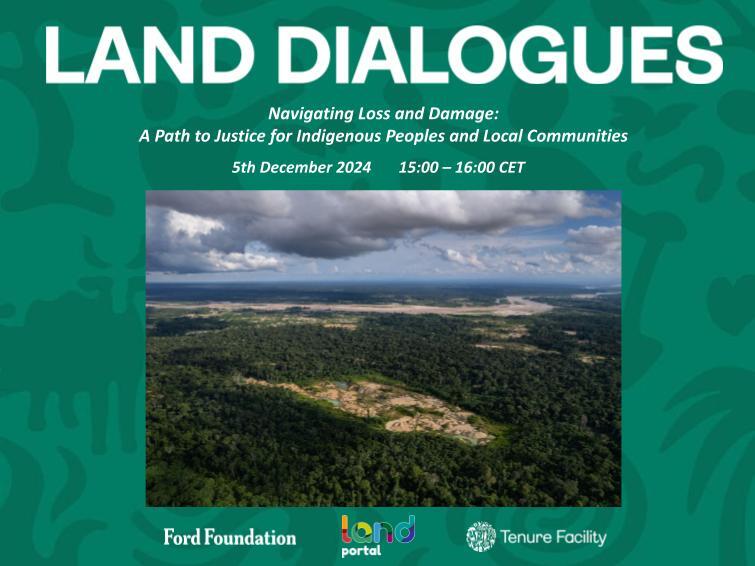2024-12-19
By Jeremy Gaunt
The initial amount of money in the United Nations’ loss and damage fund – set up at COP27 to help vulnerable communities, including Indigenous Peoples, overcome the damage of climate change – is a little over $700 million.
Not so fun fact: That’s about what the world’s 10 best-paid footballers earn each year.
Unsurprisingly, there was consensus at the latest Land Dialogues webinar on December 5 that the funding falls far, far short of what is needed. And that’s without even an understanding of just how to calculate what the real loss and damage is or will be, or where it should go.
The webinar – “Navigating loss and damage: A path to justice for Indigenous Peoples” – was sponsored by the Tenure Facility, Land Portal Foundation, Ford Foundation, and Mongabay. It brought together Indigenous and climate advocates specifically to look at the loss and damage issue.

The first and most forceful point made was that what is officially known as the “Fund for responding to Loss and Damage” is woefully insufficient.
As of November, it had received pledges from wealthier countries amounting to $731 million. In stark contrast, this was the same month that COP29 set a new target of £300 billion annually by 2035, tripling an older estimate.
“(Estimates) that have been coming out have been in the billions per year of what is needed to deal with the issues right now,” said Janene Yazzie, director of policy and advocacy at the Indigenous American-led NDN Collective.
“And when you pin on top of that, issues of inflation that are affecting every country, as well as the compounding costs of cumulative impacts in communities, even the billions estimate is nowhere near where we need to be thinking long term,” she said.
Echoing this, Heather McGray, director of the Climate Justice Resilience Fund, said the new $300 billion target was “really paltry”.
She compared it with what is already being put into subsidising the global fossil fuel industry, the main driver behind climate change. Some have estimated this at £1.8 trillion a year.
But McGray said she remained hopeful that, total money aside, the UN fund was taking steps and being creative in speeding up the ways in which money would go to where it was needed.

Andrea Carmen, executive director of the International Indian Treaty Council.
AT THE FRONT
And that includes Indigenous Peoples, who are on the front line of dealing both with the impact of climate change and efforts to mitigate it. So, the panellists also emphasised the need for them to be involved at all levels – including getting direct funding.
Yazzie, an enrolled member of the Navaho Nation, said:
“What we’re advocating for is to ensure that these (funding) mechanisms … are accessible to Indigenous Peoples, uphold the rights of Indigenous Peoples, can be utilised towards solutions and responses that are designed and prioritised by Indigenous Peoples.”
This issue – basically one of trust and understanding – was the main topic at the September 23 Land Dialogues held as part of New York Climate Week, coinciding with the United Nations General Assembly meeting.
Indigenous Peoples, in the meantime, are not just sitting around.
“We’re not waiting for funding from the United Nations or from the states that we live in, because our survival is on the line,” said Andrea Carmen, executive director of the International Indian Treaty Council.
“One thing that we are doing is to share and implement our expertise for knowledge about restoration of soil, healthy living soil that hasn’t been depleted by agrochemicals or overgrazing of invasive species, … mining, et cetera. We’re bringing back our traditional ways,” she said.
Included in this is Indigenous Peoples working together and sharing their expertise. Carmen cited Indigenous desert farmers in Africa offering advice to counterparts in Arizona, and Arizonans being asked by the United Arab Emirates to advise on desert farming because of needs in their country.
"What we're advocating for is to ensure that these (funding) mechanisms … are accessible to Indigenous Peoples, uphold the rights of Indigenous Peoples, can be utilised towards solutions and responses that are designed and prioritised by Indigenous Peoples."

Janene Yazzie, director of policy and advocacy at the Indigenous American-led NDN Collective
COUNTING THE COST
But there is another issue: even where the money is available to hit the target, how would they be used? For mitigation of the effects of climate change, or to repair the damage that has also been wrought? And how do we know what is lost?
Calculating the real cost of loss and damage due to climate change is a logistical labyrinth. One clear way to understand this came from Carmen, a member of the Yaqui Nation who is based in Arizona.
She cited the case of the Sonoran toad, found in the Sonoran Desert that stretches across northwest Mexico and the southwestern United States.
The toads historically come out when the heavy rains hit towards the end of July, beginning of August, which is harvest season.
“So, they eat the insects, right at the time when it’s most important, when our crops are coming to maturity and ready to be picked,” Carmen said.
“But a few years ago, the rainfall began to change, either not come at all or come at very different time, and this dramatically affects the life cycle of the toad. And we’ve noticed that there are hardly any anymore where there used to be after the rains, literally hundreds jumping around. This is a threat to our food systems.”
How, she asked, would the loss and damage fund compensate for that?
Articles